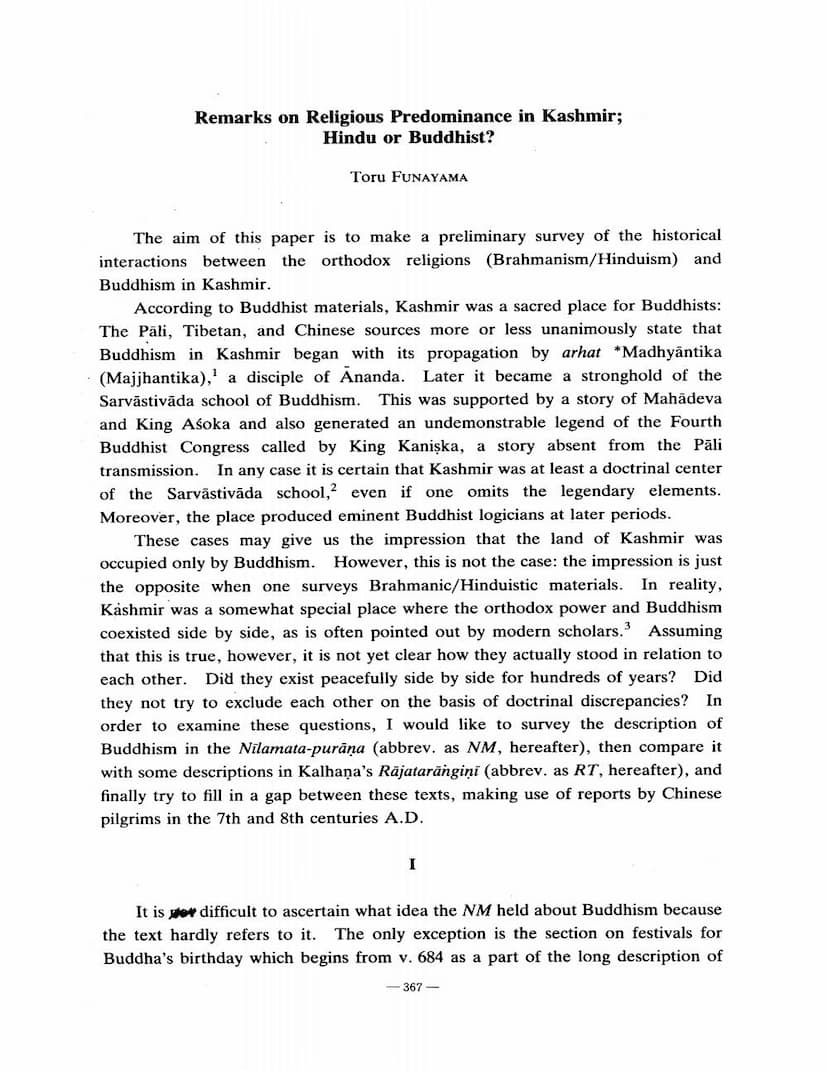Remarks On Religious Predominance In Kashmir Hindu Or Buddhist
Added to library: September 2, 2025

Summary
This paper, "Remarks on Religious Predominance in Kashmir; Hindu or Buddhist?" by Toru Funayama, explores the historical interactions between Brahmanism/Hinduism and Buddhism in Kashmir.
The author notes that Buddhist sources often portray Kashmir as a sacred place for Buddhism, highlighting its role as a doctrinal center for the Sarvāstivāda school and the legendary Fourth Buddhist Council. This might lead to the impression that Buddhism was the sole dominant religion.
However, Funayama asserts that Hindu sources present a different picture, suggesting a more complex coexistence. The paper aims to investigate the nature of this relationship by examining:
-
The Nilamata-purana (NM): The NM, according to Funayama, rarely refers to Buddhism, with the exception of a section detailing festivals for Buddha's birthday. Crucially, it frames the Buddha as an avatara (incarnation) of Vishnu. This integration suggests that Buddhism was not perceived as a threat to orthodox Hinduism within the NM's framework, implying a peaceful coexistence.
-
Kalhana's Rajatarangini (RT): In contrast to the NM, the RT (specifically, an account of King Abhimanyu I) depicts antagonism between the orthodox Brahmins and Buddhists. This story, though legendary, is presented as a sequel to the NM and suggests that, at some point before Kalhana, orthodox elements felt hostility towards Buddhism, attributing natural calamities like heavy snowfall to their practices and the displeasure of nāgas (serpent deities) whom the Buddhists neglected.
-
Chinese Pilgrims' Reports (7th and 8th Centuries A.D.):
- Early Antagonism: The paper references the legend of the propagation of Buddhism by Madhyantika, where a great nāga resisted him. This early account, found in a Chinese version, suggests that Buddhism was not immediately welcomed by the existing Kashmiri population.
- Xuanzang's account (Datang Xiyuji): Xuanzang, who visited Kashmir around 630 A.D., reports a period of anti-Buddhist sentiment following King Kaniska's death. He mentions a group called krītas (possibly foreign traders) who, due to Buddhists overturning their religion and abandoning traditional rituals, developed a grudge and attempted to destroy Buddhism. This led to the establishment of an anti-Buddhist government. However, Xuanzang also mentions a king from Himatala who restored Kashmirian Buddhism, suggesting a cyclical pattern of dominance and restoration.
- Contemporary State (circa 630 A.D.): Xuanzang's report indicates that at the time of his visit, the orthodox religion was predominant. The krītas were actively promoting anti-Buddhism and deva-temples, with Buddhism not being held in high regard.
The paper concludes by suggesting that while Buddhist sources emphasize Buddhism's prominence, Hindu sources and the reports of Chinese pilgrims reveal a more nuanced history of interaction. This history included periods of peaceful coexistence, where Buddhism was integrated into the Hindu pantheon, but also periods of significant antagonism and attempts to suppress Buddhism, often linked to the perceived neglect of traditional rituals and the displeasure of indigenous deities like the nāgas. The author acknowledges the difficulty in precisely correlating events across these different sources but highlights apparent correspondences, suggesting that religious predominance in Kashmir was not static but rather fluctuated over time.